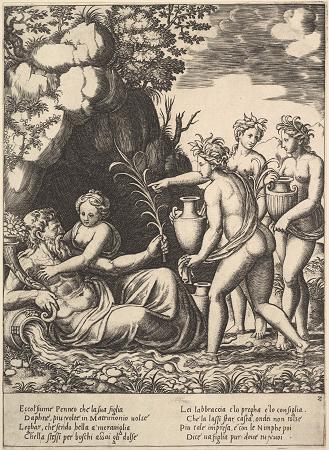Baldassare Peruzzi (1481 - 1536). Baldassare Tommaso Peruzzi was an Italian architect and painter, born in a small town near Siena and died in Rome. He worked for many years with Bramante, Raphael, and later Sangallo during the erection of the new St. Peter's. He returned to his native Siena after the Sack of Rome where he was employed as architect to the Republic. For the Sienese he built new fortifications for the city and designed a remarkable dam on the Bruna River near Giuncarico. He seems to have moved back to Rome permanently by 1535. He died there the following year and was buried in the Rotunda of the Pantheon, near Raphael. He was a painter of frescoes in the Cappella San Giovanni in the Duomo of Siena. His son Giovanni Sallustio was also an architect. Another son, Onorio, learned painting from his father, then became a Dominican priest in the convent of Santa Maria Sopra Minerva in Rome. He then stopped painting until requested by his superiors at San Romano di Lucca to paint the organ doors of the church. Almost all art critics ascribe the design of the Villa Chigi in Rome, now known more commonly as the Villa Farnesina, to Peruzzi. In this villa, two wings branch off from a central hall with a simple arrangement of pilasters, and a decorative frieze on the exterior of the building. Some of the frescoed paintings which adorn the interior rooms are by Peruzzi. One example is the Sala delle Prospettive, in which Peruzzi revived the perspective schemes of Melozzo da Forli and Mantegna, possibly under the influence of both. The walls of the room are painted so that when one stands toward the left, one has the illusion that one is standing in an open-air terrace, lined by pillars, looking out over a continuous landscape. The decoration of the facade, the work of Peruzzi, has almost entirely vanished, but it is documented by an anonymous French artist in a drawing, now held by the New York Metropolitan Museum of Art. To decorate this villa on the Tiber many artists were employed, and just as the style of the villa in no wise recalls the old castellated type of country-house, so the paintings in harmony with the pleasure-loving spirits of the time were thoroughly antique and uninspired by Christian ideas. Raphael designed the composition of the story of Amor and Psyche as a continuation of the Galatea. On a plate-glass vault Peruzzi painted the firmament, with the zodiacal signs, the planets, and other heavenly bodies. The interior room has a striking use of illusionistic perspective Peruzzi had produced a mosaic ceiling for the church of Santa Croce in Gerusalemme, Rome; the mosaic depicts the Saviour. Other paintings ascribed to him are to be found in Sant'Onofrio and San Pietro in Montorio. That Peruzzi improved as time went on is evident in his later works, e.g., the Madonna with Saints in Santa Maria della Pace at Rome, and the fresco of Augustus and the Tiburtine Sibyl in Santa Maria in Portico a Fontegiusta at Siena. As our master interested himself in the decorative art also, he exercised a strong influence in this direction, not only by his own decorative paintings but also by furnishing designs for craftsmen of various kinds. While primarily being an architect, of his great loves was drawing and he was especially well known for his extraordinary studies of antique buildings, as seen in The Mystic Marriage of Saint Catherine in the Allen Memorial Art Museum. His final architectural masterpiece, the Palazzo Massimo alle Colonne located on the modern day Corso Vittorio Emanuele, is well known for its curving facade, ingenious planning, and architecturally rich interior. The exterior details display a Mannerist-style. He made significant but unspecified contributions to what would become the Seven Books of Architecture, published in installments after Peruzzi's death by his pupil, Sebastiano Serlio.
more...











